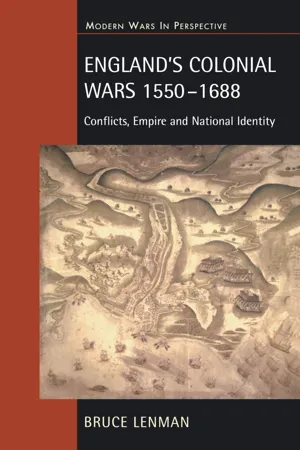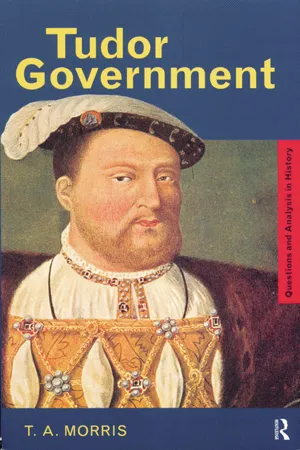History
The Tudor Dynasty
The Tudor Dynasty was a royal house that ruled England from 1485 to 1603. It was founded by Henry VII and included some of the most well-known monarchs in English history, such as Henry VIII and Elizabeth I. The Tudor period is characterized by significant religious and political changes, including the English Reformation and the expansion of England's influence abroad.
Written by Perlego with AI-assistance
Related key terms
3 Key excerpts on "The Tudor Dynasty"
- eBook - ePub
- W M Ormrod(Author)
- 2011(Publication Date)
- The History Press(Publisher)
- 6 -
The House of Tudor 1485-1603
Richard Rex
T he argument that the Tudors brought peace, stability and prosperity to England after a century of infighting and disorder is a myth very largely of their own making: Henry VII, Henry VIII and Elizabeth I were all expert in the arts of what today is called propaganda, and much of the popular modern image of those rulers still derives from the messages they chose to impart to their subjects. To an extent, the Tudors were simply the beneficiaries of an economic and cultural dispensation that gave England new wealth, new ideas, and a new sense of its own identity during the sixteenth century. On the other hand, the greatest of the Tudors, Henry VIII and Elizabeth I, clearly helped to shape the government, religion and culture of their realm in a forceful, dynamic and expansive manner that demonstrated not only the long stretch of the arm of State but the real and considerable impact of personal monarchy. Most remarkably – and something often taken too much for granted today – The Tudor Dynasty was the first successfully to establish both the principle and the practice of female monarchy: and if the experiment manifestly failed in the case of Jane Grey, and was at best of arguable success in the case of Mary I, it was spectacularly vindicated by the exceptionally durable and stable reign of Elizabeth I. Without the right of female succession, The Tudor Dynasty would have failed in 1553, and might have gone down in history more in terms of the Lancastrian regime which, to a degree, it had earlier claimed to reinstate. The triumph of pragmatism represented in the failure of the male succession and the acceptance of regnant queens in itself articulated something of the new political culture that the Tudors had embraced and imposed upon the kingdom of England.HENRY VII (1485-1509)
Henry VII was born at some distance from the English throne. His mother, Margaret Beaufort, was the great-granddaughter of John of Gaunt by his mistress, Katherine Swynford, and it was from her that Henry derived the dregs of Plantagenet blood that were his claim to the succession in 1485. His father, Edmund Tudor, was connected less directly but more respectably with royalty. He was the son of a Welsh gentleman, Owen Tudor, a minor officeholder in the Lancastrian court who won the hand in marriage of none other than Catherine of Valois, the young widow of Henry V. Henry VII made more of this connection than he did of his dubious descent from John of Gaunt: Henry V was still a charismatic enough figure to be worth invoking, even if only as a relative by marriage. The irony is that, were it not for the French Salic Law (which, though not recognized by the English, forbade female succession), Henry VII had a better claim to the French crown than to the English. - eBook - ePub
England's Colonial Wars 1550-1688
Conflicts, Empire and National Identity
- Bruce Lenman(Author)
- 2014(Publication Date)
- Routledge(Publisher)
Part One The Tudor Crown, the English Nation, and the Heritage of Anglo-Norman Expansionism 1550-1603Map 1 Dominions of the Crown of England under the Tudors, c. 1540Passage contains an image
Chapter One Colonial Englishmen face up to the Tudors
The Tudor Dynasty seized control of the Crown of England and of its core territory almost by accident. No rational observer can have been sure of the outcome when the young Henry Tudor, the future Henry VII, invaded England through Wales as the sole surviving- viable leader of the aristocratic Lancastrian faction opposed to King Richard III. Of national identity in the modern sense, he was no clear-cut example, being by birth one quarter Welsh, one quarter French, and half English. His army at the decisive Battle of Bosworth had a large French contingent in it. This was not surprising as he had invaded from France, with significant aid from its monarch, Charles VIII. That there were a thousand soldiers from England's other traditional enemy, Scotland, in his ranks, owed much to the presence of Scots mercenaries in the service of the French Crown. Welsh supporters naturally came in, though not in the numbers Henry might have hoped for. There were exiled English nobles and their followers in the invasion force, and other noble adherents of Henry's Lancastrian faction joined him later, but Henry, like his army, was a product of cosmopolitan neo-feudal political banditry. His claim to the throne was dubious. Backing him was an extreme form of risk-taking in the field of redistributive industry.That the gamble came off was due to the fact that his opponent, Richard III, proved lo be an even bigger gambler than Henry, who had been forced into this invasion by the collapse of all other options. Richard chose to try to snatch a quick victory by heading a charge against the heart of his rival's army. It was not a necessary decision by a desperate man, as the Tudor propaganda of Shakespeare's Richard III would have us believe. It was a reckless throw by a very brave one. It nearly came off. Henry's standard-bearer was killed, and his dragon standard bit the dust. Henry himself came close to death, but in the event it was Richard III who was killed. Unhorsed, his crown was knocked from his helmet, his body was hacked to pieces, and his helmet smashed into his skull.1 - eBook - ePub
- T.A. Morris(Author)
- 2005(Publication Date)
- Routledge(Publisher)
IN TUDOR MONARCHYBACKGROUND NARRATIVE
England, like most of Western Europe, was ruled by a monarchy and had been for some six centuries before the Tudors occupied the throne. In that time a range of principles had been developed to justify and to support royal government. Like their continental counterparts, English kings claimed that they ruled by divine right, by the will of God, and that they were therefore the guarantors of the stability and order that God desired on earth. In pre-Reformation Europe, such a claim facilitated a fruitful working partnership with the Church. Rebellion against the monarch was generally equated with rebellion against God and, if the rebels were defeated, they could expect to suffer horrible punishments that reflected the appalling nature of the crime of treason. If they won, and both Henry VII and Mary came to the throne essentially as successful rebels, then their triumph was represented as illustrating the divine will. The English crown passed from one generation to another by the principle of primogeniture, the right of the eldest surviving son to succeed the father. English monarchs, like others across Europe, went to considerable lengths to avoid the succession of a woman, generally considered to be incapable of exercising the coercive functions that lay at the heart of monarchy. While they did not follow France in instituting a Salic Law, which formally forbade the succession of a female, they much preferred the succession of a younger prince to that of an older princess. Thus, in 1547, the nine-year-old Edward VI succeeded his father, despite the fact that he had two half-sisters older than him. If fate forced a female ruler upon them, most people assumed that, like Mary Tudor, she would marry a strong husband, who would be capable of controlling the realm for her.At the beginning of the Tudor era the king was still in large part a warlord. It remained his primary duty to conduct the defence of the realm, to resist encroachments upon the territories and rights of his dynasty, and to combat domestic disorder. It remained true in the reigns of the first two Tudors that the king was expected to carry out such duties in person, at the head of his armies, and it required extensive rethinking to accommodate monarchs who, on account of their youth or their gender, could not fulfil these expectations. The monarch was also the protector and enforcer of the laws of the kingdom. The crown held a highly privileged position within the legal structure of the realm, but was expected to act within that structure. The powers of the Tudor monarchs were extensive, yet clearly limited. A range of political and economic functions was exclusively reserved for the monarch and none other: these constituted the royal ‘prerogative’. The monarch alone could declare war and conclude peace, arrange the marriages of members of the royal family, pardon offenders, summon and dissolve Parliament, or manage the coinage. In other respects the monarch was bound by the law. Even so strong-willed a ruler as Henry VIII felt the need to give legal basis to his break from Rome, and despite her strong conviction that her father’s actions had been contrary to the will of God, Queen Mary could not reverse them without due process of statute law.
Learn about this page
Index pages curate the most relevant extracts from our library of academic textbooks. They’ve been created using an in-house natural language model (NLM), each adding context and meaning to key research topics.


